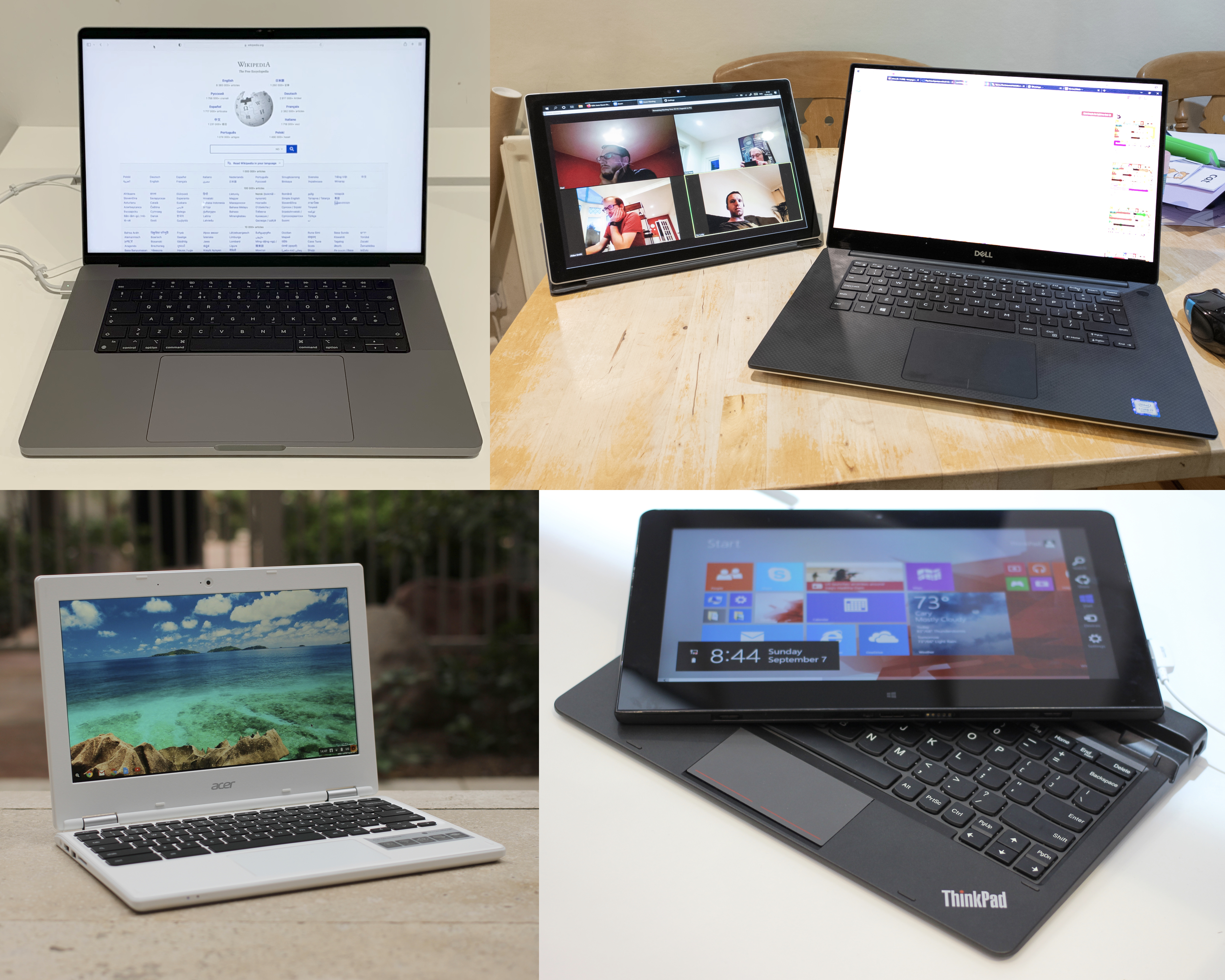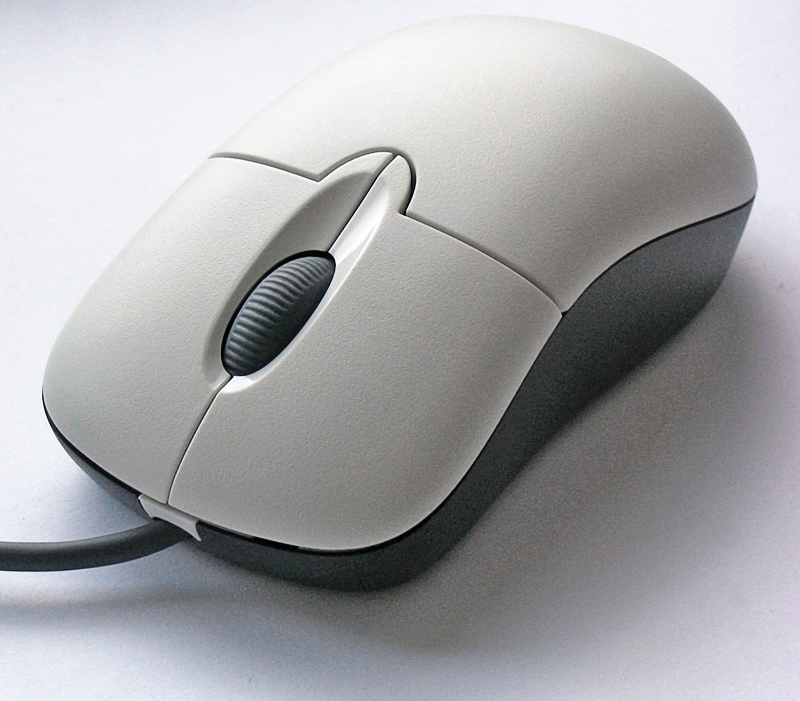|
Touchpad
A touchpad or trackpad is a type of pointing device. Its largest component is a tactile sensor: an electronic device with a flat surface, that detects the motion and position of a user's fingers, and translates them to 2D motion, to control a Cursor (user interface)#Pointer, pointer in a graphical user interface on a computer screen. Touchpads are common on Laptop, laptop computers, contrasted with desktop computers, where Computer mouse, mice are more prevalent. Trackpads are sometimes used with desktop setups where desk space is scarce. Wireless touchpads are also available, as detached accessories. Due to the ability of trackpads to be made small, they were additionally used on personal digital assistants (PDAs) and some portable media players. Operation and function Touchpads operate in several ways, including capacitive sensing or resistive touchscreen. The most common technology used in the 2010s senses the change of capacitance where a finger touches the pad. Capacitance ... [...More Info...] [...Related Items...] OR: [Wikipedia] [Google] [Baidu] |
Psion MC Series
The Psion MC (Mobile Computer) series is a line of laptop computers made by Psion PLC and launched in 1989. History Developed by Psion towards the end of the 1980s, informed by market research about the mobile computing needs of potential customers in the 1990s, the MC 400 was introduced in late 1989: an approximately A4-sized laptop or notebook computer featuring a full-size keyboard, monochrome liquid-crystal display and a multitasking, multi-window graphical user interface, providing a number of built-in applications in ROM. Instead of a mouse, the computer provided a touchpad to interact with the user interface. This was uncommon in 1989: the Gavilan SC was the only widely known model with a touchpad, and they were not used again until years later. Alongside the MC 400, the lower-specification MC 200 and MS-DOS-compatible MC 600 were announced in late 1989, with the latter scheduled for a March or April 1990 launch. The MC 200 had a "half-size screen" with a resoluti ... [...More Info...] [...Related Items...] OR: [Wikipedia] [Google] [Baidu] |
Laptop
A laptop computer or notebook computer, also known as a laptop or notebook, is a small, portable personal computer (PC). Laptops typically have a Clamshell design, clamshell form factor (design), form factor with a flat-panel computer screen, screen on the inside of the upper lid and an alphanumeric keyboard and pointing device on the inside of the lower lid. Most of the computer's internal hardware is in the lower part, under the keyboard, although many modern laptops have a built-in webcam at the top of the screen, and some even feature a touchscreen display. In most cases, unlike tablet computers which run on mobile operating systems, laptops tend to run on desktop operating systems, which were originally developed for desktop computers. Laptops are used in a variety of settings, such as at work (especially on business trips), in education, for PC game, playing games, Content creation, content creating, web browser, web browsing, for personal multimedia, and for general P ... [...More Info...] [...Related Items...] OR: [Wikipedia] [Google] [Baidu] |
Pointing Device
A pointing device is a human interface device that allows a User (computing)#End-user, user to input Three-dimensional space, spatial (i.e., continuous and multi-dimensional) data to a computer. Graphical user interfaces (GUI) and Computer-aided design, CAD systems allow the user to control and provide data to the computer using physical Mouse gesture, gestures by moving a hand-held Mouse (computing), mouse or similar device across the surface of the physical desktop and activating switches on the mouse. Movements of the pointing device are echoed on the screen by movements of the Pointer (computing WIMP), pointer (or Cursor (user interface), cursor) and other visual changes. Common gestures are point and click and drag and drop. While the most common pointing device by far is the mouse, many more devices have been developed. However, the term ''mouse'' is commonly used as a metaphor for devices that move a computer cursor. Fitts's law can be used to predict the speed with ... [...More Info...] [...Related Items...] OR: [Wikipedia] [Google] [Baidu] |
Scroll Wheel
A scroll wheel is a wheel used for scrolling. The term usually refers to such wheels found on computer mouse, computer mice (where they can also be called a mouse wheel). It is often made of hard plastic with a rubbery surface, centred around an internal rotary encoder. It is usually located between the left and right mouse buttons and is positioned perpendicular to the mouse surface. Sometimes the wheel can be pressed left and right, which is actually just two additional macros buttons. Functionality The scroll wheel is placed horizontally between the mouse buttons and commonly uses vertical scrolling, wherein rolling the wheel from the bottom side to the top is known as scrolling "upward" or "forward", while the reverse, i.e. rolling the wheel from the top side to the bottom, is known as scrolling "downward" or "backward". In a graphical user interface, the "upward" motion moves contents of the window downward (and the scrollbar thumb, if present, upward), and vice versa. ... [...More Info...] [...Related Items...] OR: [Wikipedia] [Google] [Baidu] |
Touchscreen
A touchscreen (or touch screen) is a type of electronic visual display, display that can detect touch input from a user. It consists of both an input device (a touch panel) and an output device (a visual display). The touch panel is typically layered on the top of the electronic visual display of a device. Touchscreens are commonly found in smartphones, tablet computer, tablets, laptops, and other electronic devices. The display is often an Liquid-crystal display, LCD, AMOLED or OLED display. A user can give input or control the information processing system through simple or multi-touch gestures by touching the screen with a special Stylus (computing), stylus or one or more fingers. Some touchscreens use ordinary or specially coated gloves to work, while others may only work using a special stylus or pen. The user can use the touchscreen to react to what is displayed and, if the software allows, to control how it is displayed; for example, Zooming user interface, zooming to inc ... [...More Info...] [...Related Items...] OR: [Wikipedia] [Google] [Baidu] |
Scrollbar
A scrollbar is an interaction technique or widget (GUI), widget in which continuous text, pictures, or any other content can be Scrolling, scrolled in a predetermined direction (up, down, left, or right) on a computer display, window (computing), window, or viewport so that all of the content can be viewed, even if only a fraction of the content can be seen on a device's screen at one time. It offers a solution to the problem of Web navigation, navigation to a known or unknown location within a two-dimensional information space. It was also known as a handle in the very first GUIs. They are present in a wide range of electronic devices including computers, graphing calculators, mobile phones, and portable media players. The user interacts with the scrollbar elements using some method of direct action, the scrollbar translates that action into scrolling commands, and the user receives feedback through a visual updating of both the scrollbar elements and the scrolled content. Altho ... [...More Info...] [...Related Items...] OR: [Wikipedia] [Google] [Baidu] |
Gavilan SC
The Gavilan SC is an early laptop, laptop computer first released by the Gavilan Computer Corporation in April 1984. The computer ran on an Intel 8088 microprocessor running at 5 MHz and sported a touchpad for a pointing device, one of the first computers to do so. The laptop was developed by Manuel Fernandez (businessman), Manuel "Manny" Fernandez, founder of the Gavilan Computer Corporation, and unveiled in May 1983. History The brainchild of Manuel Fernandez (businessman), Manuel "Manny" Fernandez, the Gavilan was unveiled at COMDEX#List_of_all_COMDEX_events, COMDEX/Spring '83 at the Georgia World Congress Center in late April 1983. It was unveiled a year after the Grid Compass, with which it shared several pioneering details, notably a Clamshell (form factor), clamshell design, in which the screen folds shut over the keyboard. The Gavilan, however, was more affordable than the Compass, at a list price of around USD, US$4000. Unlike the Compass, it was equipped with a flo ... [...More Info...] [...Related Items...] OR: [Wikipedia] [Google] [Baidu] |
Mouse (computing)
A computer mouse (plural mice; also mouses) is a hand-held pointing device that detects Plane (mathematics), two-dimensional motion relative to a surface. This motion is typically translated into the motion of the Cursor (user interface)#Pointer, pointer (called a cursor) on a computer monitor, display, which allows a smooth control of the graphical user interface of a computer. The first public demonstration of a mouse controlling a computer system was done by Doug Engelbart in 1968 as part of the Mother of All Demos. Mice originally used two separate wheels to directly track movement across a surface: one in the x-dimension and one in the Y. Later, the standard design shifted to use a ball rolling on a surface to detect motion, in turn connected to internal rollers. Most modern mice use optical mouse, optical movement detection with no moving parts. Though originally all mice were connected to a computer by a cable, many modern mice are cordless, relying on short-range rad ... [...More Info...] [...Related Items...] OR: [Wikipedia] [Google] [Baidu] |
Cursor (user Interface)
In human–computer interaction, a cursor is an indicator used to show the current position on a computer monitor or other display device that will respond to input, such as a text cursor or a mouse pointer. Etymology ''Cursor'' is Latin for 'runner'. A cursor is a name given to the transparent slide engraved with a hairline used to mark a point on a slide rule. The term was then transferred to computers through analogy. On 14 November 1963, while attending a conference on computer graphics in Reno, Nevada, Douglas Engelbart of Augmentation Research Center (ARC) first expressed his thoughts to pursue his objective of developing both hardware and software computer technology to ''augment'' human intelligence by pondering how to adapt the underlying principles of the planimeter to inputting X- and Y-coordinate data, and envisioned something like the cursor of a mouse he initially called a ''bug'', which, in a 3-point form, could have a "drop point and 2 orthogonal wheels". He w ... [...More Info...] [...Related Items...] OR: [Wikipedia] [Google] [Baidu] |






